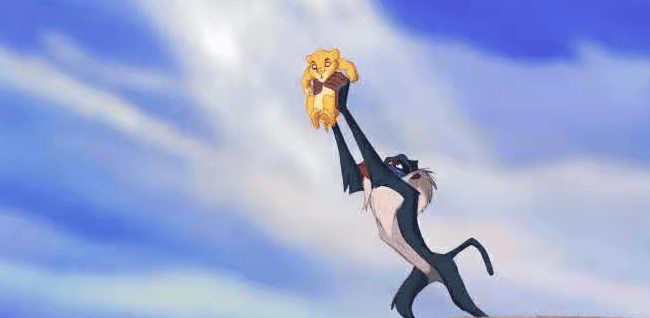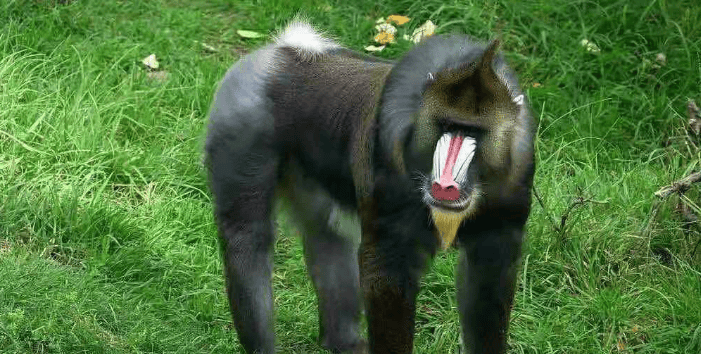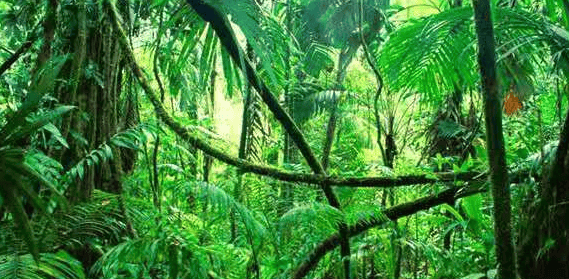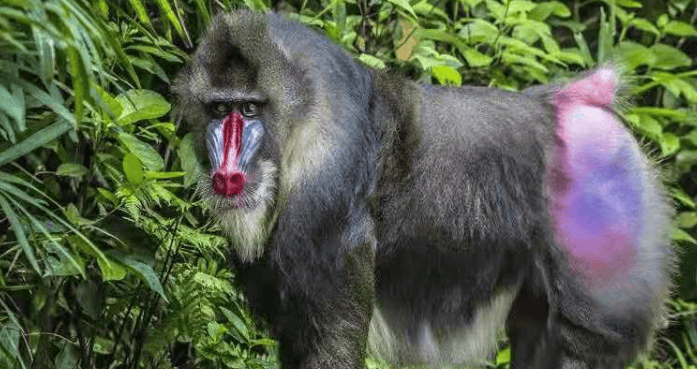The mandrill is the largest species in the primate family, also known as the ghost baboon. Its distribution area is narrow, and it is only distributed in the tropical rainforests of Cameroon, Equatorial Guinea, Gabon, Congo and other places north of the Congo River in northwest Africa [1]. Due to the shrinking of their habitats, many ferocious beasts in Africa are natural enemies of mandrills. Coupled with human hunting, the number of mandrills is also decreasing.
Its size is already famous, but how big is it? The male mandrill can reach a maximum length of 1 meter, and the maximum weight is 50 kilograms. Compared with other monkeys, mandrills are also bigger and bigger. Many people even confuse mandrills with black baboons.
Mandrills are social animals with a mixed diet. They mainly feed on fruits and seeds, and occasionally eat leaves, insects, and small vertebrates. Since the 1970s, my country has introduced and raised mandrills as ornamental monkeys in zoos such as Chengdu, Chongqing, Beijing, and Shanghai.
Perhaps because they have lived in the wild for a long time, their temperaments are very ferocious. Mandrills are born with sharp teeth and are very aggressive, and are known as "natural warriors." However, they are a little afraid of people. When people come in, they will either run away or use their buttocks to show their kindness, and then run away. They will not take the initiative to attack, and they are quite friendly to people.
Let’s take a look at some wild animals that you may not necessarily see in zoos – mandrills.

1. The appearance and growth habits of mandrills
In the mountains and wilderness, there is an old saying: "It is better to meet a jackal than a mandrill." The wizard Rafiki who lifted up Simba the lion cub in the cartoon "The Lion King" is a mandrill (this is one of the guesses, some people think it is a baboon). Research believes that mandrills are mainly distributed in Africa. In ancient Chinese historical documents It has been mentioned many times in the book, and even listed mandrills and "mountain ghosts" as the same species, saying that they are as scary as ghosts and can attack humans silently. ,
In the "Book of Mountains and Seas", it is recorded that it is "infinitely powerful and can fight tigers and leopards, the most ferocious creatures". This kind of record is full of mythological color, although there are references to mandrills in the text. Traces, but in reality, no traces of them have been found in China yet. Let’s take a look at whether the mandrills in reality are as described in the book.

1. Mandrill's special "painted face" and "rainbow" Butt: The mandrill's dramatic "painted face" is often talked about: the bridge of the nose is red, and there are deep blue-white vertical lines on both sides of the nose. Studies have found that the more excited a mandrill is, the darker its facial color will be.
Its butt is also colorful, with various red, pink, blue, purple and other colors, which are not very distinct, like a blend of colors. Darwin once wrote in "The Descent of Man": "Among all mammals, there is no creature with such strange colors as the mandrill."
Some people say that the most beautiful color combinations are the colors of nature, such as the yellow and green of sunflowers, the blue and white of blue sky and white clouds, and the black and white stripes of zebras are even more classic. When we arrived at Mandrill, we were also provided with bright and moving color combinations.

2. Mandrill's habitat: Mandrill likes to live in the tropics! In the dense forests of the rainforest, they are alert and ferocious by nature, and their activities are hidden. Perhaps because the dangers of survival in Africa are too great, they instinctively try their best to avoid all kinds of dangers. The suitable temperature range for mandrills to grow is between 20-30°C. In addition to trees, they also like to climb and perch in rocky places.
3. The mandrill’s favorite form of exercise is climbing. The mandrill's locomotion behaviors include walking, running and climbing, of which climbing behavior accounts for almost half of the locomotor behaviors. The reason for this is probably because in the wild environment, the trees in the tropical rainforest are relatively dense and there is not much space for movement on the ground, so they have developed the habit of living in trees and climbing.
When raising animals in captivity, people will also specially prepare some concrete pillars, iron fences, wire mesh, etc., which can satisfy their love for climbing even in the breeding environment.

4. Mandrill's eating behavior: in captivity Among them, it has been observed that mandrills like apples the most, and their favorite vegetable is lettuce [2]. They accept almost all kinds of fruits and vegetables that humans can eat. They are indeed omnivorous. Mandrills are very large, so their demand for food is also very large. Judging from their food, they seem to prefer "vegetarian food", which is different from the impression of ferocious large animals
5. Mandrills Living behavior: In the wild environment, there are usually one male and multiple female groups. Therefore, when raising, one male and multiple female mandrills can also be placed in the same animal house, but two male mandrills cannot be placed together, as they will fight. Behavior.
Even among animals, there is a strict "hierarchical relationship". Adult males are in the first order, and strong females are in the second order. The higher the order, the more important they are in eating, mating, You have the right to prioritize when taking breaks and other behaviors. Those with the lowest ranking should take the initiative to sort out those with higher rankings to show friendship.
These primitive hierarchical distinctions in the "animal world" appear to be more direct and simple. In comparison, the "hierarchical relationships" in human society are more complex.

In fact, there are many stories about mandrills in China. According to legend, it may be an animal that is very similar to a mandrill. The ancients did not know where the "holy god" was, so they thought it was a mandrill. If the legend is true, then sooner or later mandrills will be found in China.
2. What should I do if the mandrill is injured?
Mandrills are a highly adaptable monkey. When raised in captivity, they need to be vaccinated at the age of three months, after which they can live independently. Mandrills rarely get sick, and their health is pretty good. Diarrhea is a common disease for them, which may be caused by their mixed diet and indigestion from eating too much.
The solution can be from three aspects. First, match the appropriate meals, and secondly, pay attention to the amount of food. For mandrills that have already suffered from diarrhea, some drugs to treat diarrhea need to be added to the food.

Another disease that mandrills often suffer from is trauma. He was involved in a fight or was scratched by something sharp while climbing. Therefore, you should be prepared from the following points during the breeding process: First of all, mandrills fight in the animal house because of the division of interests, perhaps resting space, or snatching of food, so when allocating animals to one room, There are up to three adult mandrills in the house.
Secondly, there are abrasions on the iron frames around the mandrills’ activities. This requires the breeders to pay attention to whether the wire mesh surrounding the animal houses is damaged. If there are any damages, they must be repaired in time to prevent the mandrills from climbing and Injured while playing. They also have a special habit of rubbing their food on the ground. If the ground is not smooth enough, it can easily cause injuries.
It seems that caring for mandrills in the wild is not simple. Although they are not prone to diseases, you must pay special attention to these scratches. If the injuries are not treated in time, they will cause infection. Even tetanus. Therefore, care for mandrills needs to be more careful.

 扫一扫微信交流
扫一扫微信交流
发布评论